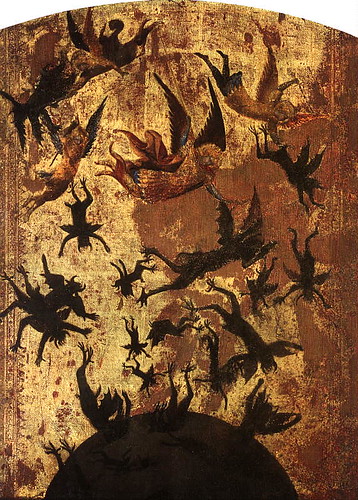Ah, the vampire, a type of
monster that never seems to go out of style. The internet has been saying that
vampires are a dead subject. Well, they are in a way, but not how they mean it.
Bloodsucking fiends have persisted throughout history in cultures around the
world. They’ve struck fear in the hearts of adults and children. They are one
of the reasons you didn’t go want to go out at night. I did a related guest
post about types of vampires a few weeks ago, which can be found
here. I’ve taken a few from that post and changed
them for my own purposes. No, there are not any vampires in
A Prescription for Delirium because
trying to fit them in the story was like shoving a square peg into a round
hole. However, there will be vampire appearances in the following books,
starting with
Omega Effect, which I
am currently writing. Below are the eight vampire types that exist in my world.
Be, warned, none of them sparkle.
“Nothing is too small. I counsel you, put
down in record even your doubts and surmises. Hereafter it may be of interest
to you to see how true you guess. We learn from failure, not from success!”
–Dr. Abraham Van Helsing.
From the Journal
of Andrei Van Helsing:
To my sons: I
leave you my legacy, as my father left it to me, and his father before him. We
are the few in the world that stand against those that feed upon humanity, the
undead. Tales and rumors have spread. Here we must separate fact from fiction
if we are to succeed.
Though the term
vampire was not used until the 1800’s, I find it a fitting term to describe
what we hunt.
The Chiang-Shih: I have never traveled
to Asia but my father Alexander traveled to China during his time. I remember him
speaking of the vampires of the east. I
have taken his description from his journal, which I implore you to read for
yourselves. They were described as nocturnal beasts with white hair and red
eyes. Their fangs extend over their lips and they have long claws. Most are
male, although there have been rare cases of females. These creatures are
incredibly violent. One can usually be found by following a string of attacks
and reports of rape on women. They have a supernatural strength, able to uproot
trees to use as weapons, have the ability to fly, and shapeshift into animals.
However, they cannot cross running water and can be destroyed with a stake of
black thorn wood.

Churel or Chedipe: This is an exclusively female type originating from India.
They can be identified with their unnaturally long, black tongues, unkempt
hair, and backwards feet. They prey on young men, starting with the ones they
were close to in life. They have been stories of these women being chosen by
Kali herself, but I don’t believe in is true. The Churel has the ability to put
an entire house in a trance like sleep and sneaks in to prey upon the men. They
can shift their bodies in that of tigers. However, these creatures can be
thwarted by a handful of seeds, for they must stop and count them. A stake made
of the wood of a fig tree will destroy them.
Hantu laut: This is the Malaysian name
for this type, though other words have been used such as siren or mermaid.
These vampires can transform themselves into water and lure sailors or beach
goers out into the water. They drown them and feed off of their blood. This is
where the myth of mermaids comes from. However, they can be male or female.
They must rest at the bottom of the body of water during the day. The sirens
can travel out of the water, but if they are caught at dawn they die. They have
power over the weather and the sea. They
can be staked with wood from an olive tree.
Asema: The vampires of South America.
They live as an old man or woman by day. When night comes the creature sheds
its skin and travels as mist or smoke. It this form it has the ability to drain
the blood of a human through the pores of their skin or enter their lungs and
cause them to cough up blood. Garlic is the best deterrent for this creature as
with any vampire. If the creature does not return to its skin by dawn, it will
be destroyed. When it is in its skin, it can be killed by a stake made of an
oak wood.

Strigoi: The Slavs and Romanians have
called these creatures many names and there are many tales of them. My
Grandfather Dimitri wrote about a theory he’d developed when gathering lore
about these creatures. This vampire was believed to pass through several
stages. For the first 40 days it starts out as a shadow, and gradually gains
power from the blood it has drank. It forms into an invisible jelly-like mass
and then to a human body almost identical to the one it had in life. The males
of this group have the ability to procreate with woman and produce the Dhampir,
half vampires. These children have the ability to see the Strigoi in all forms
and in the past were sometimes hunters, however, they can also become Strigoi
themselves. The Strigoi cast no shadow, for they are but shadows themselves.
They can be killed by a stake made of hawthorn wood.
Aswang Manananggal: This Filipino vampire detaches in head and entrails from its body
and flies about feeding on human blood, flesh, and organs. It especially like
feeding upon fetuses and had a long tongue to suck the fetus from the womb. The
Aswang Manananggal has a birdlike familiar that acts a reconnaissance for prey.
The Manananggal is usually a respected man or woman of the community by day.
Malaysia has a similar vampire called the Penanggalan. They best way to destroy
this vampire is to find the abandoned torso and cremate the body. If the head
does not reattach by dawn it will be destroyed. It can also be killed by a
stake made of cedar wood.
Doppelsauger: One of the most horrifying
of all vampires, simply because they are all dead children. They all feed off
of woman, they especially like new mothers whose breasts are full of milk. In
their true form, every part of the Doppelsauger decays except for the lips,
however they can cast an illusion upon themselves. They can be staked by wood
of juniper.
Opyri: This is the type you would know
best, for it is the children of our enemy Dracula. We have worked an wiping
this line out, unfortunately his line, like him has a tenacity to continue on.
Dracula himself
can resurrect through the bloodline of those he has cursed, such as us. They
have control over flesh and blood. This includes the ability to produce
pheromones that can memorize a person (especially women), to shapeshift, or
turn into blood itself. He can be killed and, this group above the others, are
especially susceptible to holy items. It is believed because Dracula cursed god
at his moment of creation.
Interested? Do you like stories about angels, demons, and the supernatural? Pick up a copy of "A Prescription for Delirium" available on
Amazon,
Barnes & Noble, and
Smashwords.





















,_exorcism_by_Saint_Exupere.jpg)







